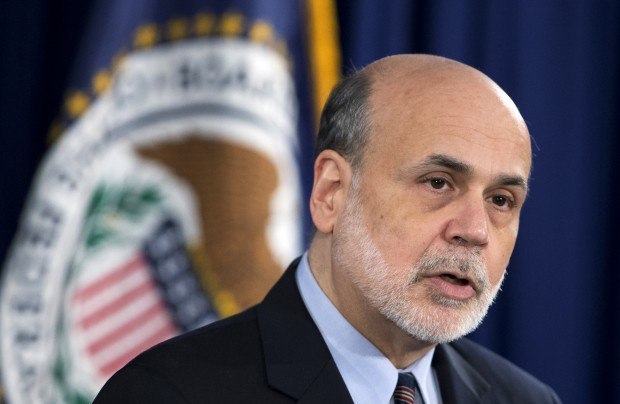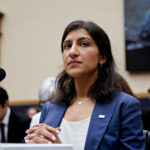Federal Reserve Chairman Ben Bernanke said on Wednesday the U.S. economy is expanding strongly enough for the central bank to begin slowing the pace of its bond-buying stimulus later this year.
Bernanke’s confirmation that the Fed is getting closer to pulling back on its $85 billion in monthly asset purchases confirmed investor fears, sending stocks and bonds sharply lower, and pushing benchmark Treasury yields to a 15-month high.
The Fed expects moderate growth to lead to a further healing in the job market as headwinds facing the economy ease, Bernanke said.
He also said policymakers expect inflation to move back up toward their long-term 2 percent goal, and dismissed recent low readings on consumer prices as due in part to temporary factors.
“The committee currently anticipates that it will be appropriate to moderate the monthly pace of purchases later this year, and if the subsequent data remain broadly aligned with our current expectations for the economy, we will continue to reduce the pace of purchases in measured steps through the first half of next year, ending purchases around mid-year,” Bernanke said.
He said the jobless rate should be down to around 7 percent from its current 7.6 percent by the time bond purchases are halted.
In a change of policy, Bernanke also said a majority of Fed policymakers believe the central bank should hang onto the mortgage assets it acquired through its unconventional monetary stimulus when it decides to tighten monetary policy.
He made the statement at a news conference on the Fed’s decision to continue buying $40 billion in mortgage-backed securities and $45 billion in longer-term U.S. government securities each month as part of its effort to keep interest rates low and boost employment.
After a two-day meeting, the Fed’s policy-setting panel offered a more upbeat assessment of the risks facing the economy than they had after they last met in May.
The committee sees the downside risks to the outlook for the economy and the labor market as having diminished since the fall,” it said.
Bernanke stressed that even a slower pace of bond buying would be adding support to the economy, and that any decision to begin removing stimulus was still a long ways off. Any eventual increases in interest rates would also be gradual, he added.
“They do indeed plan to taper purchases later this year and hope to be done by next summer. Bernanke wants to communicate that this is not necessarily tightening, but the market may not see it that way,” said Axel Merk, president and chief investment officer of Merk Investments in Palo Alto, California.
Rate Rise Not Seen Until 2015
The Fed has held overnight interest rates near zero since December 2008 while more than tripling its balance sheet to around $3.3 trillion with its bond buying.
It repeated on Wednesday that it would not raise rates until unemployment hits 6.5 percent or lower, provided that the outlook for inflation stays under 2.5 percent.
Bernanke made clear that threshold was merely for considering a rate hike, not a trigger for necessarily making one. In fresh quarterly projections, 14 of the 19 members of the Fed’s policy panel said they did not think it would be appropriate to raise rates until some time in 2015.
In a sharp downgrade, the Fed forecast the PCE price index, its preferred gauge of the price pressures facing consumers, would rise just 0.8 to 1.2 percent this year.
However, it saw inflation heading back to 1.4 to 2.0 percent in 2014 and 1.6 to 2.0 percent in 2015.
A low inflation rate could allow the Fed to keep rates lower for longer and could even force additional monetary easing if it persists or falls further.
In a slight upgrade to their projections, officials forecast unemployment to average 6.5 to 6.8 percent in the fourth quarter of next year, and 5.8 to 6.2 percent in the final three months of 2015.
They forecast U.S. economic growth of between 3.0 and 3.5 percent next year and 2.9 to 3.6 percent in 2015.
Analysts think U.S growth slowed a bit in the second quarter of this year in the face of fiscal drag from government spending cuts and higher taxes, and recent readings from the economy have been mixed.
The labor market, a central focus of Fed efforts to boost growth, has notched steady improvement with 175,000 new jobs added in May. But U.S. manufacturers have been hurt by softer overseas demand, and inflation has fallen even further beneath the Fed’s goal.
The consumer price index was up 1.4 percent in May from a year ago. But the PCE price index rose just 0.7 percent in the 12 months through April, the most recent reading.





















 E&S Property In Focus: Competition Up, Price Momentum Waning
E&S Property In Focus: Competition Up, Price Momentum Waning  Executives on the Move at AIG, White Mountains, Vermont Mutual
Executives on the Move at AIG, White Mountains, Vermont Mutual  FTC Issues Worker Non-Compete Ban as Chamber Lawsuit Looms
FTC Issues Worker Non-Compete Ban as Chamber Lawsuit Looms  The Latest Launches: Click for Cyber Insurance
The Latest Launches: Click for Cyber Insurance 



